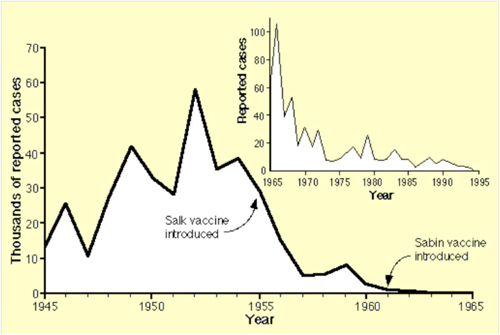The Dark Side of OPV
Vaccine-related polio (VAPP and cVDPV)
The use of oral polio vaccine in the worldwide eradication effort has performed spectacularly in limiting wildtype poliovirus transmission to only a few geographic locations. Now, the rare cases of polio related to the live vaccine are becoming more and more concerning. One extremely rare type of vaccine-related disease is vaccine-associated paralytic polio (VAPP). Even though the vaccine strains are attenuated, clinical paralytic polio may occur after the first dose in one in 1.2 million vaccine recipients. Although this may seem like an uncomfortable risk, we must remember that polio has disappeared from the U.S. (see historical graphic below) and most of the rest of the world largely because of the use of this usually safe vaccine.
However, there is yet another, more pressing concern about OPV use. It is the emergence of spontaneous mutations in OPV that restore its virulence and the capacity to be transmitted. Such mutant viruses can cause isolated outbreaks in communities that have a sizable population of unvaccinated persons. These problem viruses are called circulating vaccine-derived poliovirus (cVDPV). Fortunately, oubreaks of these viruses can be contained and controlled by redoubling immunization efforts locally.


